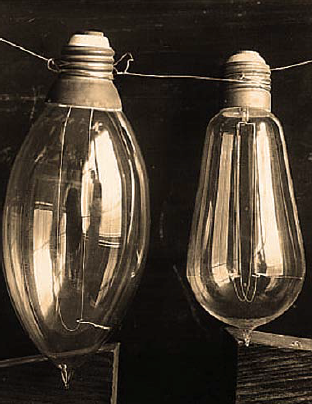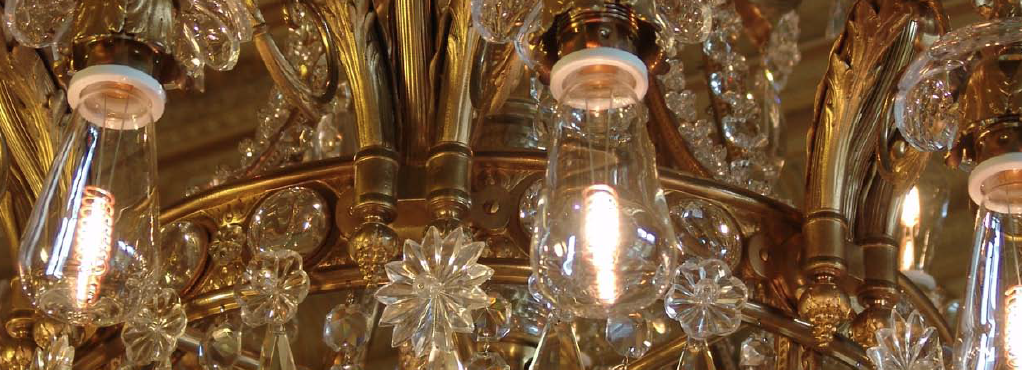An LED Solution for Historic Monumental Electric Chandeliers by Ramselaar Light Solutions
The Netherlands Institute for War Documentation (NIOD) is housed in a magnificent monumental late 19th century building at the Amsterdam Herengracht (the Netherlands). Recently, the unique brass chandeliers were provided with LED lamps, which were specially developed for this project by Ramselaar Light Solutions. Ron Ramselaar and M. Brouwers, advisor on behalf of the Government Buildings Agency (RGD), tell us about this extraordinary project.
Chandeliers with energy-efficient lamps. Can you imagine this? The Staff of the NIOD can because for years they have been working in a monumental building where the historic chandeliers were actually fitted with energy-efficient lamps (!). Recently this has changed. Although the NIOD is still housed in this beautiful former private house at the Herengracht 380- 382 dating from 1890 and which was designed by the architect Gerlof Salm, the energy-efficient lamps have now been replaced by more appropriate lighting. “These low-energy light bulbs in the chandeliers really hurt me”, says M. Brouwers, advisor on behalf of the Government Buildings Agency and as such closely involved with the replacement of the lighting in the NIOD building. “One of our jobs involved finding a new solution for the chandeliers. These historic fittings were technically worn but thanks to Ron Ramselaar we have been able to find a wonderful solution.”
The Task
Mr. Brouwers has worked for the RGD for years and is specialized in the maintenance of monuments. In his opinion the lighting in this monument urgently needed to be replaced. The fittings no longer complied with the applicable NEN 1010 standard and so there was a need to replace the fittings immediately, but then he faced the question: “now what?” The RGD were not responsible for the lighting of the work areas of the NIOD employees because, contractually, this lighting was the responsibility of the user of the building – who, incidentally, had done an excellent job by using special desk lamps. So the focus was on the general lighting in the corridors, which was solved by using contemporary functional solutions. But because of the historic value of the building, Mr. Brouwers also wanted to retain the wonderful brass chandeliers in the building as lighting elements. So the question was how to do this.
The Challenge
There were several problems that needed to be addressed: the new lighting should capture the atmosphere of 1890 and also require as little maintenance as possible. In 1890, people of course used light bulbs, but today this is no longer possible due to the ban on the use of incandescent bulbs. But even apart from this prohibition, it was not wise to use this technology in this project. Light bulbs tend to fail and some of the chandeliers – especially the suspended ones in the stairwell (15 meters high) - are so difficult to reach that the use of light bulbs was not a realistic option from that point of view either.
The Solution
A specialist in the field of (custom-built) LED lighting, Ron Ramselaar was asked to develop a LED solution for the chandeliers in the NIOD building. He took up the challenge with both hands. Rob van Beek, architect of the Government Buildings Agency, requested if it would be possible to design a lamp equipped with LED technology but with the look and feel of an old-fashioned light bulb. The latter is very important because the lamps in the chandelier are in full sight; to retain the character of the chandeliers it was essential therefore to provide the lamps with a historic look and feel.

Figure 1: One of these metal-filament lamps which were invented in 1889 by the Austrian inventor Carl Auer von Welsbach, or a carbon-filament lamp were very likely used at end of the 19th century (Credits © Bildarchiv d. ÖNB, Wien)
Providing the authentic look and feel
The developed product for the NIOD project indeed looks like a light bulb: it is a transparent glass globe provided with a brass socket. Ramselaar assembled and developed the parts himself and had the glass globe made to measure in the Czech Republic. He also developed the electronics, because they had to fit in the selected brass socket. The light is emitted from two LEDs, which are housed back-to-back in the transparent glass globe.
In the first concept, the LEDs were placed horizontally in the bulb, connected with one or two wires to the driver. But that approach did not satisfy the ideas of the architect. Furthermore, at that time no white LEDs with a CCT of about 2.200 K were commercially available, which would have been the preferable color temperature due to the 1890 original light color. Rob Van Beek then suggested to place the LEDs vertically and brought up the idea to place a copper helix around the LEDs By that ingenious and simple measure two problems were solved: The overall design pleased the architect and, thanks to the yellow color of the copper wire, the LED light of 2,700 Kelvin acquires an even warmer quality. Moreover, the reflection of the light on the copper wire offers an even more uniform view of the lamp: even if you look at the two back-to-back LEDs from the side, the light exudes warmth and character. The chosen (multichip) LEDs, which use 0.36 Watts, are oblong in shape, suggesting an actual filament in the transparent glass globe, while the CRI of the used LEDs is 85.
 Figure 2: The simple but ingenious construction of the “bulb” results in a perfect simulation of an “historic” bulb
Figure 2: The simple but ingenious construction of the “bulb” results in a perfect simulation of an “historic” bulb
Hiding the electronics
A total of approximately 250 LED solutions were used in the monumental NIOD building. The lamps operate on an external supply of 24 volts. So it is not a retrofit solution; retrofit lamps have the driver/supply in the lamp. In the case of a frosted lamp, this is easy because the supply can be concealed in the globe. But with a transparent glass globe, the electronics could only be housed in the brass socket. Obviously, this does not have enough space for an efficient 24 volt supply, while separating the LED, heatsink and driver or supply also ensures a longer life.
Historic Correctness
Every thinkable effort to make the solution as authentic as possible has been taken. This included a visit to the Electricity Museum in the town of Hoenderloo, where several old still working lamp bulbs can be admired, which allowed to measure the light intensity of original 19th century lamps. The lamps could not be too bright because the dazzle would hide the details of the chandeliers.
It can be assumed that in those days people were accustomed to candle light. The property at Herengracht 380-382 was one of the first buildings with electric light. The light intensity was very likely comparable to candle light. But one does not know that for sure. Strangely enough, relatively little is known about the nineteenth century. For a long time, this period was considered to be less interesting, architecturally. Today, at least the Government Buildings Agency thinks quite differently about this.
The Result
The special LED solutions in the NIOD building have eventually been provided with a light energy of 40 lux. - It is genuine atmospheric lighting. During a tour of the building it becomes clear what the RGD advisor means by this: the wonderful brass chandeliers in various sizes provide the imposing building with even more historic prestige, yet without the lighting compromising its functionality.
Since the LEDs work on 15 mA only (keeping the case temperature below 40 degrees), while 350 mA is permitted with good cooling, the LEDs easily last the default number of 50,000 burning hours. This means that only minimum maintenance is required. Several tests were conducted that showed that the solution opted for, may also be increased for higher light intensities. Although these tests are not relevant to the NIOD project, a similar solution could also be used in different circumstances.
Outlook
Ramselaar suspects that in the years to come he will often be asked whether there are any clear LED alternatives for the light bulb. Right now, he is busy developing a true-to-life LED alternative for the candle flame, without the flashing by the way. Figures 3-5: Equipped with this LED solution a touch of the historic look and feel is coming back to the Herengracht 380-382
Figures 3-5: Equipped with this LED solution a touch of the historic look and feel is coming back to the Herengracht 380-382

